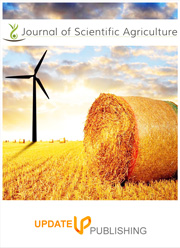A Comparative analysis associated to virulence of Pseudomonas syringae pv. garcae, the causative agent of Bacterial Blight of coffee in Kenya
DOI:
https://doi.org/10.25081/jsa.2018.v2.893Keywords:
Strains, Coffee cultivars, Virulence, Inoculation, Infection, DiversityAbstract
The Pseudomonas syringae pathogen is genetically diverse, presumably due to the adaptation of individual pathovars to suit the environments of their respective host plants. Given the immense damage and yield loss due to BBC disease that is caused by Psg, this study sought to determine the diversity associated to virulence of the PSG isolates on coffee in Kenya. Twelve strains of Psg pathogen were collected from different coffee growing regions in Kenya and characterized using both phenotypic and molecular tools using inoculation via host-pathogen interaction and genomic sequencing. The sequencing was done using 16S ribosomal RNA primers 8 F and 1492 R and sequences were then retrieved for alignment and phylogenetic analysis using MEGA 6 via clustalW. The results correlating the 16S rRNA diversity found in the strains with their virulence by inoculation in 4 different coffee genotypes revealed possible existence of different races of Psg. The study provides new knowledge on the nature of virulence of BBC pathogen and a platform towards breeding for durable resistance in Kenya.
Downloads
References
2. Michael, S. H., Morgan, R. L. Sarkar, S. F., Wang, P. W. and Guttman, D. S-Phylogenetic Characterization of Virulence and Resistance Phenotypes of Pseudomonas syringae. Appl. Environ. Microbiol. (2005) 71, 5182-5191.
3. Vinita J, Lindeberg M, Jackson R. W., Selengut J, Dodson R, Brinkac L. M., Daugherty S. C., DeBoy R, A. Durkin S, Giglio M. G., Madupu R, Nelson W. C., Rosovitz M. J., Sullivan S., Crabtree J., Creasy T., Davidsen T., Haft D. H., Zafar N., Zhou L., Halpin R., Holley T., Khouri H., Feldblyum T., White O., Fraser C. M., Chatterjee A. K., Cartinhour S., Schneider D. J., Mansfield J., Collmer A., and Buell C. R. (2005). Whole-Genome Sequence Analysis of Pseudomonas syringae pv. phaseolicola 1448A Reveals Divergence among Pathovars in Genes Involved in Virulence and Transposition. Journal of Bacteriology 187: 6488–6498
4. Mugiira RB, Arama PF, Macharia JM, Gichimu BM. Antibacterial activity of foliar fertilizer formulations and their effect on ice nucleation activity of Pseudomonas syringae pv. garcae Van Hall; the causal agent of Bacterial Blight of Coffee. Int. J. Agric. Res. (2011) 6:550–561.
5. Fekadu Alemu. Assessment of the current status of coffee diseases at Gedeo and Sidama zone, Ethiopia, International Journal of Advanced Research (2013), Volume 1, Issue 8, 192-202
6. Masaba D M. Review of Kenyan Agricultural Research (1998) Vol. 25 Coffee Physiology and Breeding
7. Kairu G. M. Biochemical and Pathogenic Differences between Kenyan and Brazilian Isolates of Pseudomonas syringae pv. garcae. Plant Pathology (1997) 46:239-246.
8. Ithiru J. M., Gichuru E. K., Gitonga P. N., Cheserek J. J. and Gichimu B. M. Methods for early evaluation for resistance to bacterial blight of coffee-African Journal of Agricultural Research (2013) Vol. 8
9. Gichuru E. K., Agwanda C. O., Combes M. C., Mutitu E. W., Ngugi E. C. K., Bertrand B. and Lashermes P. Identification of molecular markers linked to a gene conferring resistance to coffee berry disease (Colletotrichum kahawae) in Coffea Arabica-Plant Pathology (2008)57,117–1124
10. Ito D. S., Sera T., Sera G. H., Grossi L. D. and Kanayama F. S. Resistance to Bacterial Blight in Arabica coffee cultivars. Crop Breed Appl. Biotechnol. (2008) 8:99-103.
11. Janda J. M. and Abbott S. L. 16S rRNA Gene Sequencing for Bacterial Identification in the Diagnostic Laboratory: Pluses, Perils, and Pitfalls-(2007) 10.1128/JCM.01228-07
12. Ithiru JM, Gichuru EK, Alakonya AE. Identification of coffee genotypes with resistance to Bacterial Blight of Coffee isolates in Kenya. International Journal of Plant Breeding and Crop Science (2015), 2: 043-045.
13. Tamura K., Stecher G., Peterson D., Filipski A., and Kumar S. MEGA6. Molecular Evolutionary Genetics Analysis version 6.0. Molecular Biology and Evolution (2013) 30:2725-2729.
14. Tamura K. and Nei M. Estimation of the number of nucleotide substitutions in the control region of mitochondrial DNA in humans and chimpanzees. Molecular Biology and Evolution (1993) 10:512-526.
15. Felsenstein J. Confidence limits on phylogenies: An approach using the bootstrap. Evolution (1985) 39:783-791
16. Bing Yang, Akiko Sugio, and Frank F. White. Inoculation and Virulence Assay for Bacterial Blight and Bacterial Leaf Streak of Rice-Os8N3 is a host disease-susceptibility gene for bacterial blight of rice Proc Natl Acad Sci USA (July 5, 2006) 103: 10503–10508
17. Jackson R. W., Athanassopoulos E., Tsiamis G., Mansfield J. W., Sesma A., Arnold D. L., Gibbon M. J., Murillo J., Taylor J. D., and Vivian A.-Identification of a pathogenicity island, which contains genes for virulence and avirulence, on a large native plasmid in the bean pathogen Pseudomonas syringae pathovar phaseolicola. The National Academy of Sciences (1999) vol. 96 no. 19, 10875-10880
18. I Wayan Suardana, “Analysis of Nucleotide Sequences of the 16S rRNA Gene of Novel Escherichia coli Strains Isolated from Feces of Human and Bali Cattle,” Journal of Nucleic Acids, (2014) Article ID 475754, 7 pages,
19. Kolbert, CP; Persing, DH. "Ribosomal DNA sequencing as a tool for identification of bacterial pathogens". Current Opinion in Microbiology (1999) 2 : 299–305.
20. Weisburg WG, Barns SM, Pelletier DA, Lane DJ. "16S ribosomal DNA amplification for phylogenetic study". J Bacteriol (1991) 173 : 697–703.



 .
.